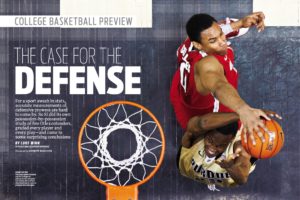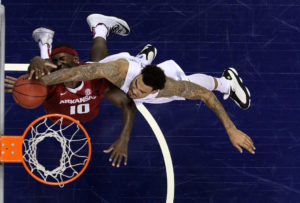College Basketball’s Defensive Dominators and Top Defensive Teams
College basketball continues down the closing stretch as teams push for regular season titles, conference championships, playoff positioning and NCAA tournament bids. Second meet situations become more intense and No. 2 Duke was a rematch winner over No. 1 Virginia 81-71 this past weekend and the Blue Devils got the season sweep over the Cavaliers. The victory also moved Duke (22-2) to the top of the ACC standings at 10-1, and Virginia (21-2) bounced back to win at North Carolina Monday and both those teams are 9-2 in ACC action. Virginia is no longer an undefeated home team after suffering their first home loss, and neither is Kentucky after losing to LSU Tuesday in a battle of 20-win teams chasing an SEC regular season title.
 There are many more key contests in February that will impact the conference standings and determine whether teams stay in the conference title chase and earn an NCAA Tournament berth. Teams that play solid defense and show improvement will often be teams you can count on, and that’s the case in the Big 12 where Kansas State (19-5) is 9-2 in Big 12 play after winning at Texas. Iowa State, Texas Tech and Kansas are still in the Big 12 title chase, and the Jayhawks are in jeopardy of having its remarkable 14-year run as regular season conference champions come to an end. A trip to Lubbock against defensive dominator Texas Tech is this weekend.
There are many more key contests in February that will impact the conference standings and determine whether teams stay in the conference title chase and earn an NCAA Tournament berth. Teams that play solid defense and show improvement will often be teams you can count on, and that’s the case in the Big 12 where Kansas State (19-5) is 9-2 in Big 12 play after winning at Texas. Iowa State, Texas Tech and Kansas are still in the Big 12 title chase, and the Jayhawks are in jeopardy of having its remarkable 14-year run as regular season conference champions come to an end. A trip to Lubbock against defensive dominator Texas Tech is this weekend.
Handicappers, bettors and sports books adjust to the momentum swings, lines and the change in scoring and pace of play with the shot clock reduction. This season, there are 9 college basketball team’s averaging 83 points per game; down significantly from last year and also the year prior when 14 teams averaged 83 PPG through the first week in February. There is also 17 teams making at least 10 three-pointers per game, which is down from 27 last year in early February.
But as handicappers evaluate players and teams, and make adjustments to scoring, possessions, power ratings and three-point shooting, it’s still important to follow the basic principles and fundamental focus when you evaluate stats and how teams play. On offense the  team must value the basketball with a positive assist to turnover ratio. Good shot selection remains an important if a team wants to experience success. Thus coaching philosophies of good shot selection and the concepts of boxing out and rebounding are key to increasing the number of possessions, as is the percentage of loose balls and steals a team can create. Converting a high percentage of foul shots is key, especially late in games.
team must value the basketball with a positive assist to turnover ratio. Good shot selection remains an important if a team wants to experience success. Thus coaching philosophies of good shot selection and the concepts of boxing out and rebounding are key to increasing the number of possessions, as is the percentage of loose balls and steals a team can create. Converting a high percentage of foul shots is key, especially late in games.
Utilizing a site like KenPom.com can provide you key stats, adjusted numbers, efficiency and tempo ratings along with match-up analysis. However, I also go to conference web pages and review stats and specifically at this time of year conference only statistics for teams and players. With so many stats and situations to evaluate, a good indicator of a team’s success and ability to compete consistently can be gauged in opponent’s field goal percentage.
Field goal percentage defense is more important than points allowed, because an opponent’s points can be determined to a degree by the number of possessions they have which in turn can be influenced by an offensive pace that creates lower overall possessions in a game. That’s why you see a top team like Virginia slow down teams every year. Influenced and led by one of the nation’s premier coaches in Tony Bennett, the Cavaliers defend relentlessly and force long possessions. It takes a superior talented team with a good offensive ability like Duke to have success against Virginia. it also takes strong discipline, quality point guard play and minimizing turnovers to be a better and more efficient team.
Isolating a team’s overall defensive field goal percentage and 3-point field goal percentage defense remain key indicators when judging a team’s defensive ability. These must work in tandem to be efficient since a team can pack the paint defensively to minimize higher percentage two-point shots while sacrificing defense outside the arc. Conversely, too much attention to perimeter defense can sacrifice a team’s ability to defend the paint. When a team combines solid defensive play with rebounding strength and the ability to block or alter shots, you have a team that is capable of competing most any night against any team.
Yet, while strong defensive play is often key to winning more basketball games, successful teams also take care of the basketball, minimize turnovers and have a solid assist/turnover ratio. This is where a strong point guard and leader, along with perimeter defense plays a key part. The ability to create steals and take good shots while controlling the boards inside creates more opportunities, possessions and shots. Thus, look at rebounding rate as another key indicator when evaluating match-ups and working in tandem with defensive shooting percentage and efficiency. Deficient defensive teams often struggle, and many of those teams are in the bottom half of the standings for a reason.
Lol pic.twitter.com/A6L7UOyGoH
— Mark Ennis (@MarkEnnis) February 10, 2019
With these concepts in mind it’s up to the handicapper and sports bettor to determine a team’s motivation level, how they match-up with each opponent and how these statistics can be used and adjusted throughout the season based on quality of opponent faced. Some teams play softer schedules and opponents in the early part of the season while also adjusting to new players, coaches and systems. I like to focus on “conference only” statistics as a more accurate barometer of a team’s overall strength. As teams push towards the finish of the conference season and into postseason play, we have a more accurate barometer with a number of games and meaningful conference stats to review. You can use some of the stats below for the rest of the regular season and into post season play as you do your match-up analysis. The defensive dominator chart is also a good guide to reference for the start of next season when factoring in returning starters, coaching philosophy and a team’s defensive strength in a system.
The stats below are season-long numbers and it’s up to you to dig deeper into a team’s stat profile and recognize opponents faced, home/road splits, player injury impact, motivational factors and other scheduling and situations including quality coaching.
Through February 12, 2019 here are the top defensive teams in college basketball with the following parameters:
- Allow 42% of less field goal percentage
- Allow 33% or less shooting from behind the 3-point arc
- Allow 67 points or less per game
I’ve also noted how these defensive dominators do in rebounding the basketball and provided their Adjusted Defensive Efficiency Ranking from KenPom (353 teams).
From the Defensive Dominator chart below, also note that these teams are top-15 in the country in opponent average scoring margin: Gonzaga, Duke, Virginia, Nevada, Michigan State, Houston, Lipscomb, Texas Tech, Michigan.
| Team | Conference | FG% Def | 3-pt FG% Def | PPG Def | Rebound Margin | Adj Def Rank |
| Houston | AAC | 36.4 | 27.1 | 60.7 | 7.8 | 11 |
| S. Fla (USF) | AAC | 40.7 | 31.4 | 65.6 | 6.9 | 33 |
| Cen. Fla (UCF) | AAC | 39.5 | 31.8 | 64.5 | 1.3 | 48 |
| Stonybrook | Amer. East | 38.8 | 29.9 | 66.4 | 6.5 | 27 |
| VCU | Atlantic 10 | 37.6 | 25.4 | 62.8 | 0.8 | 5 |
| Davidson | Atlantic 10 | 40.7 | 32.1 | 65.1 | 0.2 | 69 |
| St. Louis | Atlantic 10 | 41.4 | 30.1 | 64.6 | 6.3 | 53 |
| Virginia | ACC | 37.7 | 26.7 | 54.4 | 6.7 | 3 |
| Duke | ACC | 38.6 | 29.5 | 65.5 | 7.1 | 5 |
| Georgia Tech | ACC | 38.9 | 27.7 | 64.2 | -1.6 | 12 |
| Syracuse | ACC | 39.4 | 31.5 | 64.1 | -0.6 | 25 |
| Texas Tech | Big 12 | 36.2 | 27.3 | 57.3 | 2.6 | 1 |
| Kansas State | Big 12 | 41.1 | 31.4 | 59.3 | 2.8 | 7 |
| Baylor | Big 12 | 41.3 | 32.9 | 64.3 | 6.2 | 42 |
| Iowa State | Big 12 | 41.5 | 32.5 | 66.8 | 1.5 | 45 |
| Michigan State | Big Ten | 37.1 | 31.8 | 66.8 | 9.2 | 8 |
| Wisconsin | Big Ten | 39.5 | 30.7 | 61.1 | -0.5 | 6 |
| Michigan | Big Ten | 39.7 | 30.4 | 57.1 | 2.1 | 2 |
| Maryland | Big Ten | 40.1 | 32.5 | 64.9 | 10.4 | 17 |
| Nebraska | Big Ten | 40.4 | 31.4 | 64.6 | -1.1 | 35 |
| Old Dominion | Conf USA | 38.2 | 32.9 | 61.1 | 5.3 | 57 |
| Akron | MAC | 40.6 | 30.9 | 62.9 | -1.1 | 28 |
| Nevada | Mtn West | 40.4 | 31.7 | 66.6 | 2.1 | 27 |
| Washington | Pac-12 | 40.8 | 31.9 | 64.5 | -0.7 | 14 |
| Oregon | Pac-12 | 40.7 | 29.6 | 64.2 | 1.3 | 26 |
| Florida | SEC | 41.8 | 32.1 | 63.8 | -1.3 | 10 |
| Texas State | Sun Belt | 41.4 | 29.7 | 65.9 | 5.9 | 50 |
| Gonzaga | West Coast | 38.3 | 29.9 | 65.3 | 6.8 | 21 |
Also, some teams not on the list are solid defensive teams and may also have positive coaching profiles. These teams just miss qualifying in various categories with 3-point defense a lacking stat profile, but they still rank top-40 in adjusted defensive efficiency:
Arizona State, Buffalo, Cincinnati, Clemson, Kentucky, Marquette, Tennessee, Texas, Virginia Tech
Use some of these stat profiles as a guide when handicapping the rest of the college basketball season along with the college conference tournaments (CCT’s), NCAA Tournament, NIT and other post season tournaments.
Article posted at osga.com.

 Twitter
Twitter Facebook
Facebook